Most people only hear owls, but some folks are lucky enough to catch a glimpse of a large owl swooping across the road after dark. Most owls in Maryland are secretive and active at dusk and dawn or at night.
Eighteen species of owls can be found in North America, eight of which occur in Maryland. Barred Owls, Barn Owls, Eastern Screech-Owls and Great-Horned Owls are commonly found throughout Maryland. Northern Saw-Whet Owls migrate through the State in late fall and a few occasionally breed in western Maryland in the summer. Short-Eared Owls and Long-Eared Owls historically nested in Maryland, but no breeding birds have been seen in a number of years. Snowy Owls occasionally migrate through the State and can be seen along Assateague Island.
Specialized Predators
Owls are carnivorous and have special adaptations that enable them to hunt at night. For example, their eyes are large and fixed, with binocular vision and good depth perception. Because owls are unable to move their eyes, they have developed an incredibly flexible neck that allows them to turn their head 270 degrees, from one side to the other. (Humans can only rotate their heads about 180 degrees.) Their eyes are also extremely light sensitive, allowing them to see well at night.
Another essential adaptation that allows owls to hunt at night is their extremely sensitive hearing. It is the owl’s facial disc that enables it to hear a soft rustling in the grass as the disc acts to funnel and amplify all sound to their ears. Many owls also have asymmetrical ears which allow the owl to detect the distance and direction from which sound is coming more accurately.
Owls also rely on silent flight to surprise their prey. Owl feathers are long and soft to help muffle sounds while flying. In addition, the leading edge of their flight feathers is soft and wavy to eliminate noise while flying. These are all perfect adaptations for finding and catching prey at night, and explain why owls have become the most efficient hunters of the night.
Owl Profiles
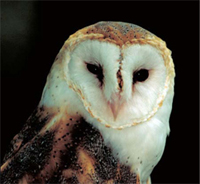
|
Barn Owls are often found in rural areas near farmland and open countryside. They usually reside in the lofts of abandoned barns or silos but will also use nest boxes. Barn Owls have golden-buff markings on their wings and back, and a white chest that may be mottled with few black spots. Their heart-shaped face makes them easy to identify. Barn Owls make a variety of sounds including a hiss and a rasping screech that has been mistakenly identified as the terrifying screams of a woman. They primarily eat meadow voles and other rodents that are commonly found in farm fields. Barn Owls breed between April and early May and produce four to six young per year. Barn Owls are found throughout Maryland at any time of the year but are considered to be rare to uncommon.
Click here to find out more about Barn Owls in Maryland |
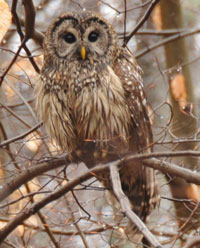
|
Barred Owls are found along rivers in low-lying woods. This large owl has no ear tufts and has dark brown eyes. The Barred Owl can be recognized by the “barred” feather pattern running horizontally across its chest and down its belly. Barred Owls have a very distinctive call that sounds like “Who cooks for you? Who cooks for you all?” Feeding mainly on meadow voles, they may prey upon birds, frogs, and crayfish. They seem to be attracted to campfires and bright lights, where they are often seen foraging for large insects. Barred Owls nest in cavities and use abandoned crow, squirrel, and hawk nests. Barred Owls can be found throughout Maryland at any time of the year. Click here to check out a
Barred Owl Nest Box Plan |
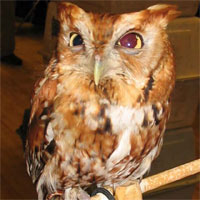 | The
Eastern Screech-Owl lives in wooded areas adjacent to open fields and nests in tree cavities or nest boxes. Adults average around 8 to 9 inches tall and are found in two color morphs - a gray phase and a reddish-brown phase. They have two tufts of feathers called “ear tufts,” which are not actually ears but feathers used to camouflage themselves within tree foliage. Though their name implies that they make a screeching sound, their call is more comparable to the “whinny” of a horse. Eastern Screech-Owls hunt at night and eat small rodents, flying insects and small birds. Year-round residents of Maryland, they are fairly common in suburban areas. Click here to check out a
Screech Owl Nest Box Plan |
 | The
Great-Horned Owl is found in many habitats but prefers dense woodlots bordering open fields. The largest of the tufted owls, they have large yellow eyes, a white throat patch, and are reddish brown, gray, or black and white in color. They make the familiar “hoo hoo” call associated with owls. Great-Horned Owls feed on waterfowl, rabbits, squirrels, marsh birds, rodents, reptiles, and amphibians. They nest in tree cavities, nest boxes, and cliff ledges, as well as the old nests of crows, squirrel, and hawks. Great-Horned Owls live in Maryland year round.
|
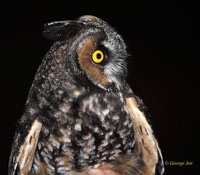 | The
Long-Eared Owl lives in coniferous forests and thick woods and hunts in open fields and marshes. Long-Eared Owls look similar to Great-horned Owls but are smaller, more slender in shape and tend to have a rustier facial disc compared to Great-Horned Owls. Long-Eared Owls make a long “hooooo” call and feed on voles and small mice. Long-Eared Owls tend to use old American Crow or squirrel nests as well as occasional tree cavities. Long-Eared Owls once nested in Maryland but now are only seen as occasional migrants through the State. |
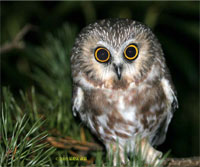 | The
Northern Saw-Whet Owl lives in low, moist coniferous or mixed forests, wooded swamps or evergreen thickets. They are the smallest owls in Maryland and average only 7 inches as adults. Saw-Whet owls are brown with a reddish facial disc and underside. They have yellow eyes and lack “ear tufts.” The sound of their call resembles the “whetting” or sharpening of a saw. Saw-Whet Owls feed on small rodents, including deer mice, shrews, and voles, but may also eat insects. They nest in natural cavities and those excavated by woodpeckers, but will also accept nest boxes. Northern Saw-Whet Owls are highly migratory and rarely spend the summer or winter in Maryland. |
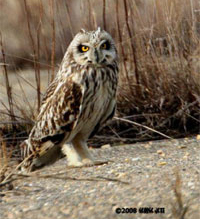 | The
Short-Eared Owl lives in fresh and saltwater marshes, bogs, prairies and grasslands and open woodlands. Short-Eared Owls are medium-sized owls with rounded wings. Their facial disc is whitish with dark areas around their eyes, while the rest of their body is brown to buff with heavy streaks. Short-Eared Owls have small “ear tufts”. Short-Eared Owls make a scratchy-barking call and feed almost exclusively on voles and other small rodents. Short-Eared Owls nest on the ground in tall grasses but sometimes they also use nest boxes. Short-Eared Owls are mainly only seen in Maryland during fall migration, though they historic records show they once bred in Maryland. |
 | The
Snowy Owl lives in open tundras and nests on the ground. They are large, white owls with dark bars and spots on their wings, breast and back. Snowy Owls feed mostly on lemmings but also consume other small rodents and birds. Snowy Owls typically occur in parts of the northern United States and Canada but migrate south during the winter where they can sometimes be seen in Maryland. |
Attracting Owls
If your neighborhood or property has a number of mature or dead trees or logs, then you may already have nesting Eastern Screech Owls. If you live in a relatively wooded area near a river, then you may have a nesting pair of Barred Owls. Rural areas that are wooded may be inhabited by Great-Horned Owls. During winter, areas with stands of evergreens are highly preferred as roosting sites for many species of owls. This is because dense vegetation, like evergreens, provides the best camouflage from potential predators. The key to attracting owls is to have their favorite nesting habitat. Neighborhoods with areas of tall grass or properties that are wooded and/or near a stream or river with an abundance of ground cover will provide the most food for owls.
If you live in an area with tall grass or near a stream, but without many mature or dead trees, then you can build nest box structures that may attract owls. Wooded properties may also attract Great-Horned Owls if a nesting structure, similar to the ones used in nature, is provided.
Invite Wildlife to Your Backyard!
For more information, please contact:
Maryland Department of Natural Resources
Wildlife and Heritage Service
Tawes State Office Building, E-1
Annapolis MD 21401
410-260-8540
Toll-free in Maryland: 1-877-620-8DNR
[email protected]
Acknowledgements:
- Barn Owl by USFWS
- Barred Owl by Mark Goss
- Eastern Screech-Owl by Kerry Wixted
- Great-Horned Owl by Ronald Laubenstein (USFWS)
- Northern Saw-whet Owl by George Jett
- Short-eared Owl by George Jett
- Snowy Owl by Middleton Evans